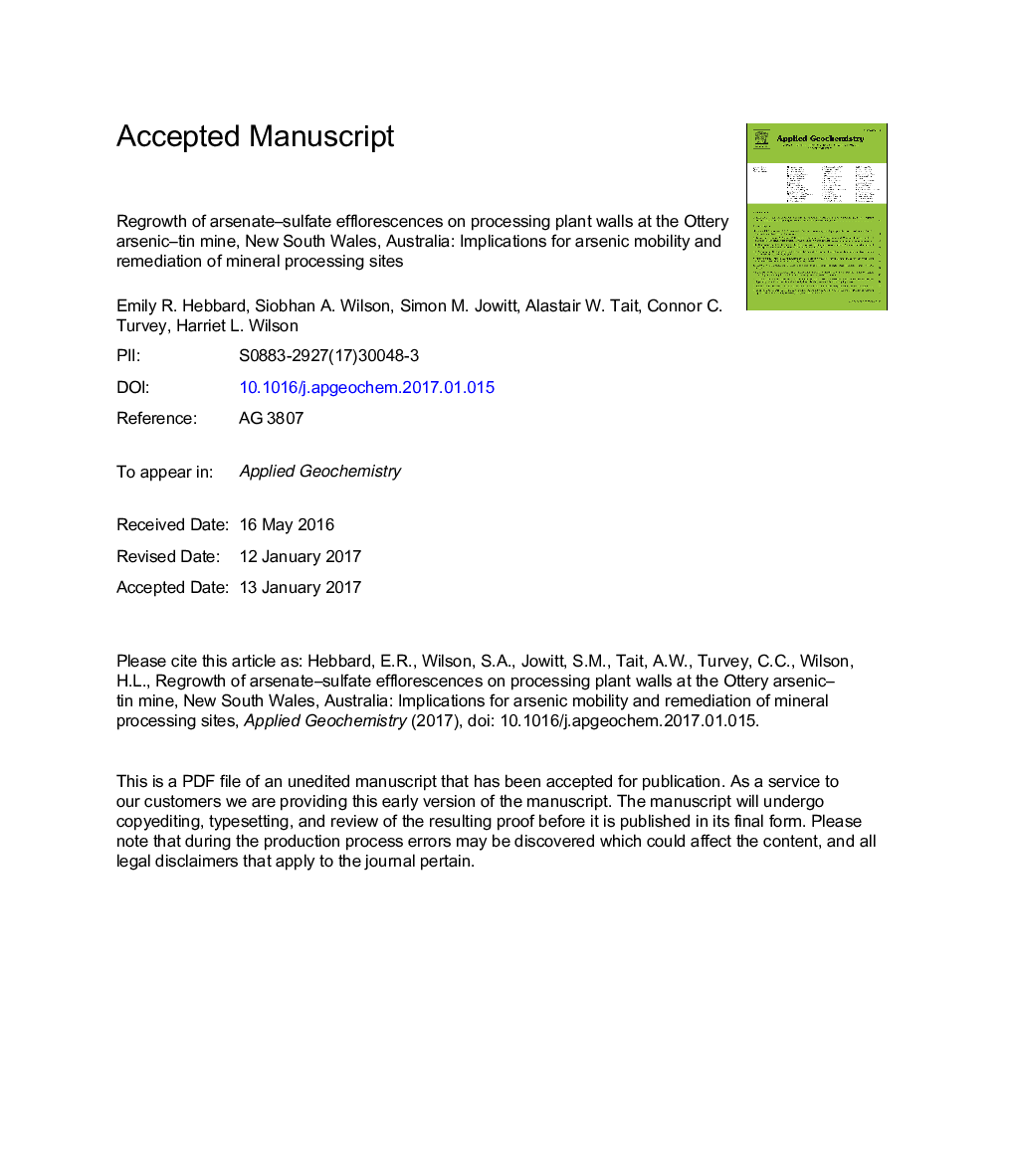| کد مقاله | کد نشریه | سال انتشار | مقاله انگلیسی | نسخه تمام متن |
|---|---|---|---|---|
| 5752573 | 1620212 | 2017 | 47 صفحه PDF | دانلود رایگان |
عنوان انگلیسی مقاله ISI
Regrowth of arsenate-sulfate efflorescences on processing plant walls at the Ottery arsenic-tin mine, New South Wales, Australia: Implications for arsenic mobility and remediation of mineral processing sites
دانلود مقاله + سفارش ترجمه
دانلود مقاله ISI انگلیسی
رایگان برای ایرانیان
کلمات کلیدی
موضوعات مرتبط
مهندسی و علوم پایه
علوم زمین و سیارات
ژئوشیمی و پترولوژی
پیش نمایش صفحه اول مقاله

چکیده انگلیسی
Processing equipment and buildings at derelict mine sites are commonly coated in metal- and metalloid-rich residues that can significantly contribute to acid and metalliferous drainage, potentially polluting soils and watercourses. Here, we describe arsenic-rich residues and efflorescences on processing buildings at the derelict Ottery As-Sn mine in New South Wales, Australia and use the resulting data to determine the mineral hosts for arsenic and their distribution at the site. X-ray diffraction (XRD), portable X-ray fluorescence (XRF) and scanning electron microscopy (SEM) data are used to conduct mineralogical, geochemical and microstructural analysis of the efflorescences. Brickwork columns within As condenser buildings are coated primarily with gypsum (CaSO4·2H2O) and contain approximately 1-5 wt% As, but more sheltered columns are associated with efflorescences rich in arsenolite and claudetite (polymorphs of As2O3) and contain up to â¼70-80 wt% As. The efflorescences within the Ottery condensers commonly contain minor quartz (SiO2), feldspars, and two uncharacterised phases, including a K-Al-As phase and a Ca-Na-K-Al-F-As phase that are likely similar to previously reported phases from an As processing site in Cornwall, UK. SEM imaging indicates that the weathering of mortar and bricks provides a source of cations for efflorescence formation, with grains of more resistant minerals (e.g., quartz) incorporated into the efflorescences. Arsenic does not appear to substitute significantly for S in gypsum but instead is generally hosted in (1) Al, Na, Ca and Fe-bearing arsenate minerals in weathered efflorescences and (2) in small grains of arsenolite in pore spaces within the brickwork, indicating that the bricks are a potentially long-lived source of As. The efflorescences on exposed columns at Ottery also regrow within 12 months after removal, releasing stored arsenic from the brickwork and causing a cyclical degradation of the buildings. Our results indicate that brickwork buildings at mine sites like Ottery initially act as significant sinks for As within arsenolite. Over time, this As can become mobilised by rainfall to form arsenate-sulfate efflorescences, which gradually become more sulfate-rich as the arsenate minerals are removed by weathering. Thus, remediation efforts at abandoned, As-bearing processing buildings, such as those at Ottery, should focus on preventing water contact with bricks and mortar within processing buildings as well as efflorescences. This research, combined with the remediation and research undertaken in similar areas such as the UNESCO Cornish Mining World Heritage Site in the UK, an area containing many derelict, arsenic-bearing processing buildings that have been successfully remediated and are now tourist attractions, indicates that a delicate balance needs to be found between remediation and resolving pollution issues and retaining the industrial heritage represented by these processing sites.
ناشر
Database: Elsevier - ScienceDirect (ساینس دایرکت)
Journal: Applied Geochemistry - Volume 79, April 2017, Pages 91-106
Journal: Applied Geochemistry - Volume 79, April 2017, Pages 91-106
نویسندگان
Emily R. Hebbard, Siobhan A. Wilson, Simon M. Jowitt, Alastair W. Tait, Connor C. Turvey, Harriet L. Wilson,